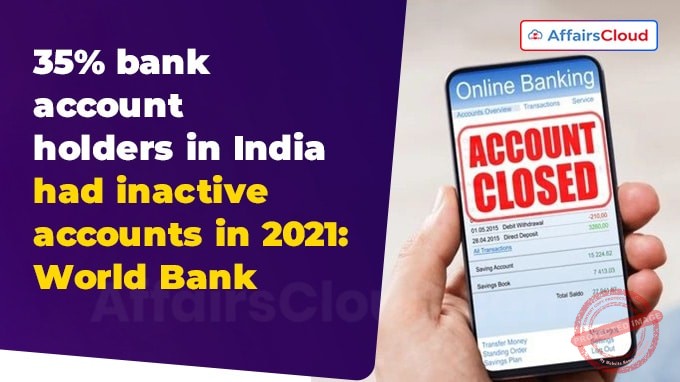 In July 2025, the World Bank (WB) has released the 5th edition of its Global Findex Database titled “Connectivity and Financial Inclusion in the Digital Economy”. As per the report, financial account ownership in India rose sharply to 89% in 2024, up from 77.5% in 2021 and a significant leap from just 35% in 2011.
In July 2025, the World Bank (WB) has released the 5th edition of its Global Findex Database titled “Connectivity and Financial Inclusion in the Digital Economy”. As per the report, financial account ownership in India rose sharply to 89% in 2024, up from 77.5% in 2021 and a significant leap from just 35% in 2011.
- The Global account ownership rate stood at 79%, an increase of 28% points since 2011, when the first round of Global Findex data was collected.
- In low- and middle-income economies, account ownership grew from 42% in 2011 to 75% in 2024, while in most high-income economies, it surged to 95% in 2024, from 87% in 2011.
Note: Account ownership is defined as a person having an account at a bank or similar institution or with a mobile money provider.
About Global Findex Report:
i.The Global Findex Report was prepared by the Finance and Private Sector Development team of the Development Research Group in theWB’s Development Economics Vice Presidency.
- Since 2011, it has been published every 3 years.
ii.It is the world’s only demand-side survey focused on financial inclusion and serves as a key source of data on how adults globally access and utilize financial services.
iii.The Global Findex 2025 features a new addition, the ‘Digital Connectivity Tracker’, which assesses both access to and usage of mobile technology.
Assessment:
The World Bank surveyed approximately 145,000 adults across 141 economies over the course of calendar year 2024.
- These data are used to track progress towards the United Nations Sustainable Development Goals (UN-SDG).
Key Highlights of Global Findex Report 2025:
Global Trends:
i.As of 2024, around 1.3 billion adults globally remain unbanked, lacking access to financial accounts and, consequently, the benefits of the formal financial system. Of these, over 700 million are women.
- In low- and middle-income economies, more than 650 million (mn) adults without financial accounts reside just in 8 countries – Bangladesh, China, the Arab Republic of Egypt, India, Indonesia, Mexico, Nigeria, and Pakistan.
ii.Europe and Central Asia have the largest share of women without accounts at 61%.
- Turkey drives this high percentage, with 77% of its adults without accounts are women.
Higher share of inactive accounts:
i.In India, the inactive account holder status i.e., non-usage of accounts in the past 12 months in 2024 is 16% of account holders, compared to the global average of 6%.
ii.In low- and middle-income economies (excluding India), the inactivity rate falls to 3% or 4% of account owners.
Mobile Money:
i.From just 2% of adults globally having a mobile money account in 2014, to 15% globally and 18% in low- and middle-income economies.
- 40% of adults in Sub-Saharan Africa had a mobile money account as of 2024, up from 27% in 2021 (highest rate of mobile money account ownership of any world region).
ii.Out of the above 89% account ownership in India, 88.7% were held with a bank/financial institution and 23.1% reported having a mobile money account.
iii. Only 48.5% of Indian adults made or received a digital payment in the past year.
Note: Mobile money refers to financial transactions and services that can be carried out using a mobile device and these services may or may not be linked to a bank account.
Gender gap:
i.The gender gap in account ownership has narrowed to 4% globally, and 5% in low- and middle-income economies. As of 2024, 73% of women in low and middle-income economies had accounts, up from just 50% in 2014 and 66% in 2021.
ii.Between 2021 and 2024, the gender gap in active accounts narrowed from 12% to 7% points, driven mainly by increased digitisation of government payments to women. Digital receipt of government-to-person (G2P) transfers among women rose from 13% in 2021 to 24% in 2024.
iii.In High-income economies, there is no significant gender gaps in account ownership, whereas:
iv.The mobile phone ownership among women likely contributes to the narrowing gender gaps.
- Only 66.5% of adults in India own a personal mobile phone, with just 42% having a smartphone. Notably, just 38.3% of phone users have enabled password protection on their devices, raising security concerns.
Other Key Highlights:
i.Saving:The share of adults saving formally in low- and middle-income economies increased across all regions between 2011 and 2024.
- In low- and middle-income economies it increased from 17% in 2011 to 40% in 2024.
- East Asia and Pacific registered the largest increase, at 20%, driven by an increase of 22% in China alone.
- India exhibits mixed financial behaviour, with just 38.6% of adults saving money in the past year, formally or informally, while 63.3% reported borrowing funds during the same period.
ii.Digital Payments: The use of digital payments among account owners is high across all regions except South Asia where just 57% of account owners made or received digital payments.
- In India, the share of account owners who used digital payment stood at 54%
iii.Digital Merchant Payments: The use of digital merchant payments—payments made by retail customers to businesses in stores or online grew to 42% of all adults in 2024, up from 35% in 2021.
- Across low- and middle-income economies, it is 82% of account owners.
- 27% in East Asia and Pacific region
- 51% in Europe and Central Asia
About World Bank (WB):
President – Ajay Banga
Headquarters – Washington, D.C., United States of America(USA)
Member Nations – 189
Established – 1944




